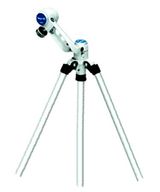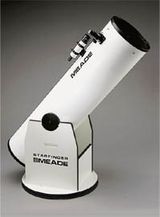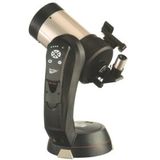| Telescope Mounts | |
| The type of mount you choose for your telescope is just as important as what type of telescope you choose. Some mounts are bettor for tracking object, others are easy to manuever when you are hopping around the sky. | |
| Equatorial | |
 | An equatorial mount has one axis lined up with the axis of the earth and the other with the earth's equator. The benefit of this set up has to do with keeping an image in the eyepiece. Since the earth is constantly turning on its axis, when we magnify a planet, star, or other object, it tends to drift out of the eyepiece. The more magnification we use the faster it will drift out of the field of view. With an equatorial mount, once an object is located, you only need to move one axis to keep it in the eyepiece. |
| Alt azimuth Mount | |
 | This is the simplest type of telescope mount. It has only up/down (altitude) and left/right (azimuth) motions. It is used primarily for low to medium power Dobsonian telescopes and terrestrial spotting scopes, as it cannot easily follow at high powers the seemingly curved paths taken by celestial objects as they cross the sky. With a alt-az mount, we need to adjust both axis to keep the object in the eyepiece which can be a difficult task. |
| Dobsonian | |
 | The most popular alt azimuth mount, designed by John Dobson, is called a dobsonian mount or "Dob". While these mounts are not ideal for tracking and object, they are the best arrangement for finding and pointing to an object. To many amateur astronomers finding the object is more rewarding than looking at it. Because a dob mounted telescope is easy to set up and maneuver, it is a popular telescope among amateur astronomers. |
| Fork Mount | |
 | A type of mount used on short tube catadioptric telescopes in which the telescope tube is mounted between two arms connected to a motor drive. An equatorial wedge and field tripod are used tilt the scope over to align it on the celestial pole for proper tracking. Setting circles are provided to locate celestial objects by their right ascension and declination coordinates. The r. a. setting circle is usually driven by the scope's motor drive to move across the sky at the same speed as the stars, following their apparent motion. |
| Go-To | |
 | Other modern "go-to" scopes use an alt-az mount called a fork mount. Because these mounts are computer controlled, the drive system can accurately move the scope on two axis to keep an object accurately aligned. |
